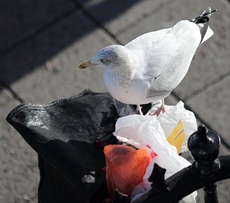Seabirds dying because of plastic waste
02 Sep 2015
The majority of seabirds are swallowing pieces of plastic waste, a new study has found; many become unwell and some die as a result.
 | |
| Photo: Peter Harriman |
The number of birds found to have plastic in their stomachs has increased from 5 per cent in 1960 to 80 per cent in 2010, and an estimated 90 per cent of all seabirds alive today have eaten plastic of some kind, according to a research paper published today in the journal Proceedings of the National Academy of Sciences (PNAS).
Plastics including bags, bottle caps, and plastic fibres from synthetic clothes, wash out into the oceans from urban rivers, sewers and waste deposits.
Birds mistake the brightly coloured items for food, or swallow them by accident. The items often block their guts so they cannot properly digest food, which causes them to lose weight, and can lead to their death.
The threat of plastic to the world's seabirds, such as albatrosses, shearwaters and penguins, can be reduced by effective waste management, say the study's authors from Imperial College London and the Commonwealth Scientific and Industrial Research Organisation (CSIRO) in Australia.
99% by 2050
The researchers found that while plastic had been found in the stomachs of 80 out of 135 seabird species (60 per cent) in 2010, they estimated that if the current upwards trend continues, 99 per cent seabirds of species will have swallowed plastics by 2050.
Dr Chris Wilcox from CSIRO, led the study with co-authors Dr Denise Hardesty, also from CSIRO, and Dr Erik van Sebille from the Grantham Institute at Imperial College London.
''For the first time, we have a global prediction of how wide-reaching plastic impacts may be on marine species – and the results are striking,'' says Dr Wilcox, a senior research scientist at CSIRO Oceans and Atmosphere. ''We predict, using historical observations, that 90 per cent of individual seabirds have eaten plastic. This is a huge amount and really points to the ubiquity of plastic pollution."
Ecosystem indicators
Dr Denise Hardesty from CSIRO Oceans and Atmosphere says seabirds are excellent indicators of ecosystem health. ''Finding such widespread estimates of plastic in seabirds is borne out by some of the fieldwork we've carried out where I've found nearly 200 pieces of plastic in a single seabird,'' she says.
The researchers found plastics are having the greatest impact on wildlife where they gather in the Southern Ocean, in a band around the southern edges of Australia, South Africa and South America.
Dr Erik van Sebille, from the Grantham Institute at Imperial College London, says the plastics have the most devastating impact in the areas where there is the greatest diversity of species. ''We are most concerned about species such as petrels, shearwaters and giant albatrosses, which live in areas near the mainland shore, islands or the Southern Ocean, where they are part of a large complex ecosystem of animals feeding on each other," van Sebille says. ''While the infamous garbage patches in the middle of the oceans have strikingly high densities of plastic, very few animals live here.''
Opportunity for change
According to Dr Hardesty, there is still the opportunity to change the impact plastic has on seabirds. ''Improving waste management can reduce the threat plastic is posing to marine wildlife,'' she says. ''Even simple measures can make a difference. Efforts to reduce plastics losses into the environment in Europe resulted in measureable changes in plastic in seabird stomachs with less than a decade, which suggests that improvements in basic waste management can reduce plastic in the environment in a really short time.''
''This is a highly important study that demonstrates just how pervasive plastics is in our oceans,'' says Dr George H. Leonard, chief scientist at the US-based Ocean Conservancy. ''Hundreds of thousands of volunteers around the world come face-to-face with this problem during annual Coastal Cleanup events. Scientists, the private sector and global citizens working together against the growing onslaught of plastic pollution can reduce plastic inputs to help protect marine biodiversity.''
The work was carried out as part of a national marine debris project supported by CSIRO and Shell's Social investment program as well as the marine debris working group at the National Center for Ecological Analysis and Synthesis, University of California, Santa Barbara, with support from Ocean Conservancy.













.jpg)






.jpg)









